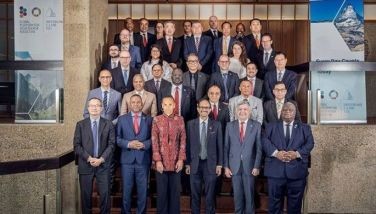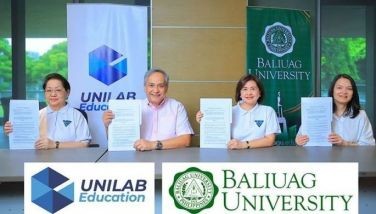Al-Ghozi probers look into conspiracy angle

July 21, 2003 | 12:00am
Nobody believes that a confessed terrorist can casually walk out of a high-security cell just from plain laxity of guards or poor jail construction. Interior Sec. Jose Lina declares it can only be "an inside job." PNP Dir. Gen. Hermogenes Ebdane chimes in that "money changed hands," and Palace spokesman Ignacio Bunye is sure "there was connivance." So investigators of Fathur Rohman al-Ghozi’s escape from Camp Crame are now exploring the conspiracy angle. And their focus is on three PNP-Intelligence Group officers: Supt. Reuben Galban, and Sgts. Puentegardo Campo and Ruperto Principe.
Galban has been relieved from his post as head of PNP-IG’s Foreign Intelligence Liaison Office (FILO). The unit coordinates operations against international terrorists with foreign lawmen, and is in charge of detention cells at the IG building’s second-floor. Probers say Galban is uncooperative and flunked a lie-detector test when asked two crucial questions: was there collusion, was money involved? They are piecing together his movements just before and on the night of the escape.
It has been established that al-Ghozi escaped with two Abu Sayyaf detainees between 10 p.m. Sunday (13 July) and 5 a.m. Monday. The sentry logbook showed that Galban left the IG compound in his Toyota van twice between 11 p.m. and 2 a.m. Asked about this, he claimed to be on his way home but drove back upon realizing he had not turned off his computer. The first time he left, the sentry noted that Galban had two companions in the van. There was no mention of companions the second time.
Campo, Galban’s chief clerk, also flunked the polygraph test. On the night of the escape, he was FILO’s alert-team officer; that is, he was to head any call for quick response. But investigators discovered that Campo had been boozing at the FILO mess hall with duty guard PO1 Ronald Palmares and an off-duty agent. Why Galban allowed his men to drink on duty – at headquarters at that – he has yet to explain. Palmares at first told probers he was asleep when al-Ghozi et al. disappeared, but now denies it. During Friday’s reenactment of how it happened, he insisted to reporters that the escape was contrived by unnamed higher-ups, and that he would reveal everything after consulting with lawyers.
Principe was the only other duty guard on the second floor that night. At the time of the escape, he claimed to be out buying snacks. He and Palmares were charged in court last week, along with jail superiors Supt. Guillermo Danipog and Insp. James Dime, for infidelity in the custody of prisoners. Administrative cases of gross negligence have also been filed against the four.
In a police organization notorious for bata-bata (favoritism), the probe must trace who the officers’ padrinos (patrons) are. Chief Supt. Eduardo Matillano, head of the Criminal Investigation and Detection Group that is looking into the escape, said in a radio interview Saturday that Galban is a protégé of Dir. Julius Yarcia. Campo, in turn, has long been his sidekick. The STAR reported yesterday that Principe is close to Dir. Jewel Canson.
Yarcia was Director for Intelligence in 1999 and head of the Western Visayas region in 2000. He is now "floating", the term used for officers with no field or staff position but required to report daily. Canson, a principal suspect in the revived Kuratong Baleleng massacre case of May 1995, was reported to have fled last March to the US.
Matillano admitted that another officer, Supt. Glenn Dumlao, had left last May from Camp Crame custody. A suspect in the Nov. 2000 kidnap-murder of prominent publicist Bubby Dacer and driver Emmanuel Corbito, Dumlao surrendered to the IG in mid-2001. Witnesses pointed to him as the head of the Presidential Anti-Organized Crime Task Force team that, in compartmentalized military fashion, turned over the victims from the abduction team to the executioners. Dumlao turned state witness and implicated his superiors, PAOCTF deputy Cesar Mancao and operations head Michael Ray Aquino. New witnesses in the Kuratong case then implicated Dumlao, however. Mancao and Aquino fled to the US soon after Dumlao’s arrest. Dumlao, too, is believed to be in California.
In exploring the conspiracy angle, investigators are determining if al-Ghozi’s escape was timed to ridicule Ebdane, the PNP and the Arroyo administration. Ebdane was supposed to serve as PNP chief for only one year, up to last July 4, but President Gloria Arroyo extended his term till November. The PNP has been regaining its image with a series of big drug busts in recent days. On the day of the escape Mrs. Arroyo and visiting Australian Prime Minister John Howard were to witness the signing of two anti-terrorism accords in which Australia would give the Philippines $5 million for specialist police training. The pacts follow closely similar US aid packages as President George W. Bush’s appreciation for Mrs. Arroyo’s anti-terrorism drive. The President’s poll ratings had been rising as she prepares for her final State-of-the-Nation Address on Monday. Al-Ghozi’s flight marred all these.
Investigators are also asking why al-Ghozi, convicted to 17 years in prison for illegally possessing explosives, was kept at the loose cell on the IG’s second floor. Another Indonesian terrorist Agus Dwikarna is held at the stricter ground-floor jail.
IG insiders recalled that when they first arrested al-Ghozi in Jan. 2002, they threw him in the second-floor cell that each has three cubicles with separate doors. They hurriedly built the ground-floor cells for tighter security, and moved him there four months later.
Galban, on interrogation, claimed he moved al-Ghozi back up only weeks ago for easier access for questioning. Moro separatist leader Muklis Yunos, had just been captured and confessed to his and al-Ghozi’s roles in the Rizal Day bombings of 2000. Galban alleged that he needed to confirm Yunos’s statements with al-Ghozi, so it was better to have him beside his office. Probers found this inconsistent. For Galban had opted to keep Yunos at the ground floor.
Catch Linawin Natin, Mondays at 11 p.m., on IBC-13.
E-mail: jariusbondoc@workmail.com
Galban has been relieved from his post as head of PNP-IG’s Foreign Intelligence Liaison Office (FILO). The unit coordinates operations against international terrorists with foreign lawmen, and is in charge of detention cells at the IG building’s second-floor. Probers say Galban is uncooperative and flunked a lie-detector test when asked two crucial questions: was there collusion, was money involved? They are piecing together his movements just before and on the night of the escape.
It has been established that al-Ghozi escaped with two Abu Sayyaf detainees between 10 p.m. Sunday (13 July) and 5 a.m. Monday. The sentry logbook showed that Galban left the IG compound in his Toyota van twice between 11 p.m. and 2 a.m. Asked about this, he claimed to be on his way home but drove back upon realizing he had not turned off his computer. The first time he left, the sentry noted that Galban had two companions in the van. There was no mention of companions the second time.
Campo, Galban’s chief clerk, also flunked the polygraph test. On the night of the escape, he was FILO’s alert-team officer; that is, he was to head any call for quick response. But investigators discovered that Campo had been boozing at the FILO mess hall with duty guard PO1 Ronald Palmares and an off-duty agent. Why Galban allowed his men to drink on duty – at headquarters at that – he has yet to explain. Palmares at first told probers he was asleep when al-Ghozi et al. disappeared, but now denies it. During Friday’s reenactment of how it happened, he insisted to reporters that the escape was contrived by unnamed higher-ups, and that he would reveal everything after consulting with lawyers.
Principe was the only other duty guard on the second floor that night. At the time of the escape, he claimed to be out buying snacks. He and Palmares were charged in court last week, along with jail superiors Supt. Guillermo Danipog and Insp. James Dime, for infidelity in the custody of prisoners. Administrative cases of gross negligence have also been filed against the four.
In a police organization notorious for bata-bata (favoritism), the probe must trace who the officers’ padrinos (patrons) are. Chief Supt. Eduardo Matillano, head of the Criminal Investigation and Detection Group that is looking into the escape, said in a radio interview Saturday that Galban is a protégé of Dir. Julius Yarcia. Campo, in turn, has long been his sidekick. The STAR reported yesterday that Principe is close to Dir. Jewel Canson.
Yarcia was Director for Intelligence in 1999 and head of the Western Visayas region in 2000. He is now "floating", the term used for officers with no field or staff position but required to report daily. Canson, a principal suspect in the revived Kuratong Baleleng massacre case of May 1995, was reported to have fled last March to the US.
Matillano admitted that another officer, Supt. Glenn Dumlao, had left last May from Camp Crame custody. A suspect in the Nov. 2000 kidnap-murder of prominent publicist Bubby Dacer and driver Emmanuel Corbito, Dumlao surrendered to the IG in mid-2001. Witnesses pointed to him as the head of the Presidential Anti-Organized Crime Task Force team that, in compartmentalized military fashion, turned over the victims from the abduction team to the executioners. Dumlao turned state witness and implicated his superiors, PAOCTF deputy Cesar Mancao and operations head Michael Ray Aquino. New witnesses in the Kuratong case then implicated Dumlao, however. Mancao and Aquino fled to the US soon after Dumlao’s arrest. Dumlao, too, is believed to be in California.
In exploring the conspiracy angle, investigators are determining if al-Ghozi’s escape was timed to ridicule Ebdane, the PNP and the Arroyo administration. Ebdane was supposed to serve as PNP chief for only one year, up to last July 4, but President Gloria Arroyo extended his term till November. The PNP has been regaining its image with a series of big drug busts in recent days. On the day of the escape Mrs. Arroyo and visiting Australian Prime Minister John Howard were to witness the signing of two anti-terrorism accords in which Australia would give the Philippines $5 million for specialist police training. The pacts follow closely similar US aid packages as President George W. Bush’s appreciation for Mrs. Arroyo’s anti-terrorism drive. The President’s poll ratings had been rising as she prepares for her final State-of-the-Nation Address on Monday. Al-Ghozi’s flight marred all these.
Investigators are also asking why al-Ghozi, convicted to 17 years in prison for illegally possessing explosives, was kept at the loose cell on the IG’s second floor. Another Indonesian terrorist Agus Dwikarna is held at the stricter ground-floor jail.
IG insiders recalled that when they first arrested al-Ghozi in Jan. 2002, they threw him in the second-floor cell that each has three cubicles with separate doors. They hurriedly built the ground-floor cells for tighter security, and moved him there four months later.
Galban, on interrogation, claimed he moved al-Ghozi back up only weeks ago for easier access for questioning. Moro separatist leader Muklis Yunos, had just been captured and confessed to his and al-Ghozi’s roles in the Rizal Day bombings of 2000. Galban alleged that he needed to confirm Yunos’s statements with al-Ghozi, so it was better to have him beside his office. Probers found this inconsistent. For Galban had opted to keep Yunos at the ground floor.
BrandSpace Articles
<
>
- Latest
- Trending
Trending
Latest
























